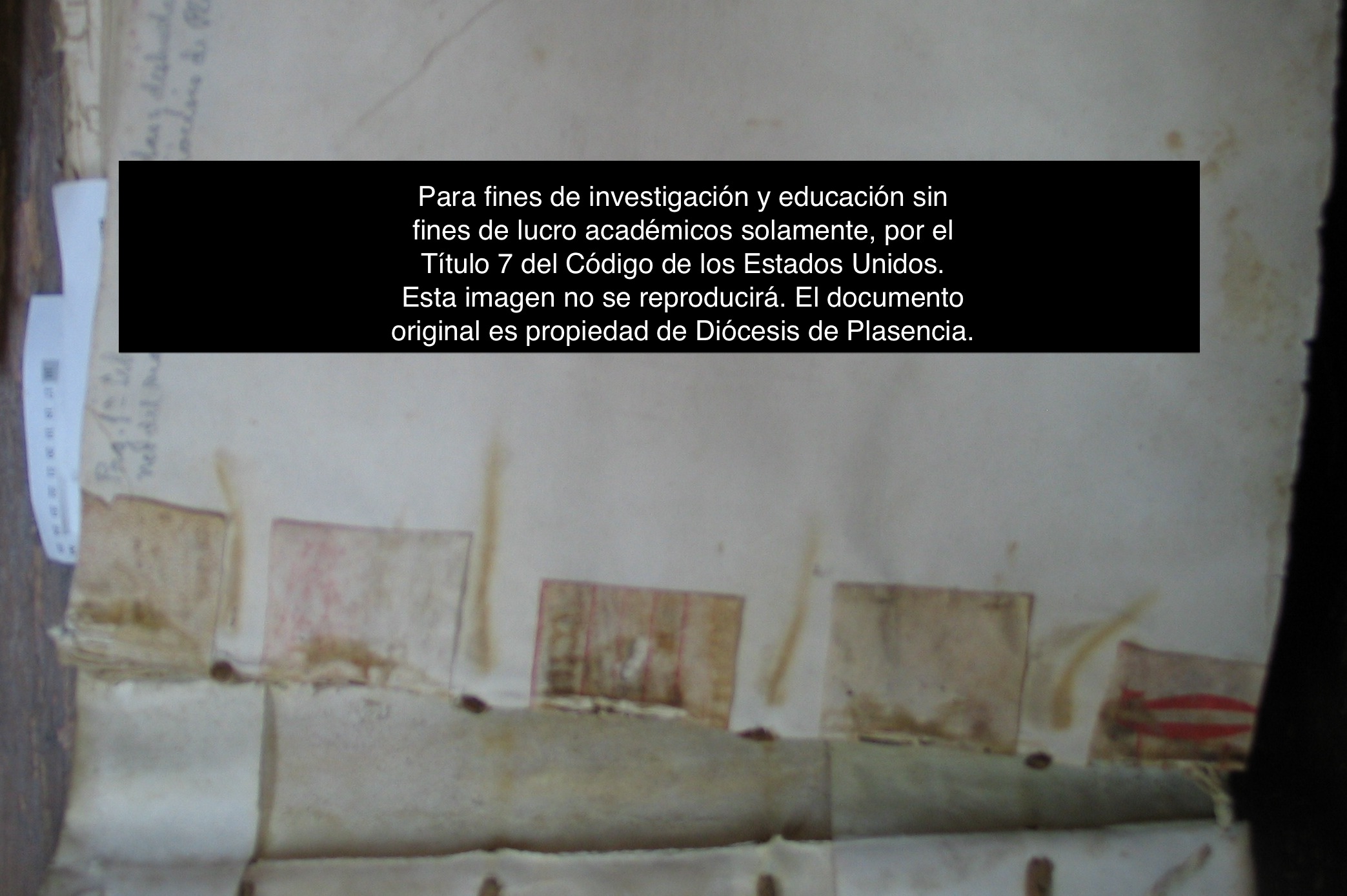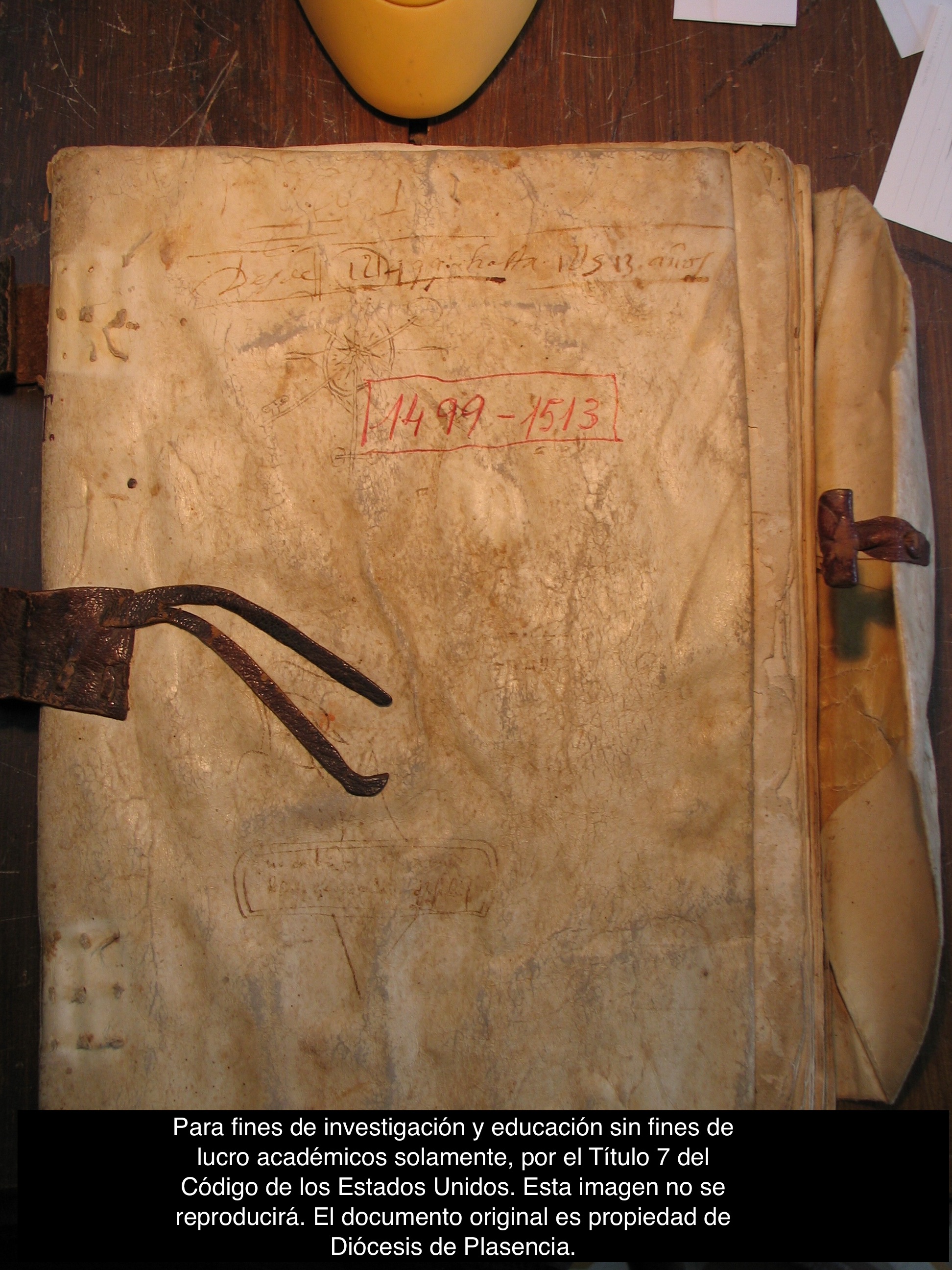About the Actas Capitulares – The Chapter Acts
[/lab_heading]
The Cathedral of Plasencia’s Actas Capitulares (The Chapter Acts)
The Actas Capitulares are the day-to-day business transactional records of the Cabildo de la Catedral de Plasencia, or the local cathedral chapter. The Actas Capitulares commence in the early 1390s and detail church statutes, properties, and organizational affairs. On first inspection, the Actas Capitulares (referred to as “Actas”) appear to be pre-bound, chronologically ordered, vellum-covered volumes of local church affairs. Once the scribe recording these church affairs completed a volume, he recorded inclusive dates on its cover, and a subsequent volume was prepared for the next series of dates.[/lab_scroll_box]

For the time period (1399 – 1527) that we are investigating, the Actas are composed of six volumes that report overlapping time periods. (See Table: Characteristics of the Actas Capitulares Volumes 1-6.) For instance, records from 1502 are located in three volumes: Volume IV (1498-1508), Volume V (1499-1513), and Volume VI (1502-1527.) Because the records for 1502 are include in three separate volumes, we can most likely deduce that the chapter collected and bound individual paper manuscript sheets into volumes at some point after the documents were completed. At irregular time intervals, it appears that the Cabildo instructed the church scribe to collect and arrange all those loose documents for the most recent period and then to have those documents bound into a chronological volume. Since we know the Actas report overlapping time periods, it is reasonable to speculate that the scribe did not locate all of the loose documents for specific years on his first search or some documents were either initially misplaced or lost. If the scribe located additional documents, it appears old volumes of the Actas were not unbound, but rather the church staff simply inserted those loose pages in the front of the next volume. Because the volumes were prepared in this manner we cannot be certain that additional documents were not lost, destroyed, or never included during the binding process, and as such, the volumes could have been subjected to selective inclusions. In fact, there are pages in the first volume which are presented out of chronological sequence.
[/lab_scroll_box]
Likewise, it is important to note that Actas Volume II is missing and may have included records as early as the 1420s and as late as the 1460s. Since the volume numbering system was created before this volume was lost, we can safely assume that the Volume II was removed at some point after 1498. Interestingly, this period overlaps considerably with the bishoprics of Bishop Gonzalo Garcia de Santa Maria and Bishop Juan de Carvajal, and the intensive interaction of the Carvajal and Santa Maria clans.[/lab_scroll_box]
| Volume | Time Period | Overlap | Internal Biding | External Biding |
|---|---|---|---|---|
| I | 1399-1453 | None | Individually stitched pages. Five minutes (5) glued vellum tabs indicative of repair. Five (5) reinforcing cords. |
Hevy vellum. Five (5) reinforcing cords sewn to internal biding. |
| II | Missing | Missing | Missing | Missing |
| III | 1459-1476 | None | Individually stitched pages. Three (3) reinforcing cords. |
Hevy vellum. Three (3) reinforcing cords sewn to internal biding. |
| IV | 1498-1508 | 1499-1502 | Individually stitched pages. | Hevy vellum. Two (2) reinforcing leather tabs sewn to external and internal biding. |
| V | 1459-1476 | 1499-1513 | Individually stitched pages. | Hevy vellum. Two (2) reinforcing leather tabs sewn to external and internal biding. |
| VI | 1502-1527 | 1502-1513 | Individually stitched pages. | Hevy vellum. Two (2) reinforcing leather tabs sewn to external and internal biding. |

Detail of Bindings

Volumes I and III share common internal and external binding methods, except for the additionally adhered vellum tabs on Volume I and fewer reinforcing cords used on Volume III. As these two volumes span over seventy-seven years it seems likely that two different individuals prepared these bindings. However, because both volumes use similar binding methods, it seems likely that the second was crafted by someone that had learned his skills from the person that prepared Volume I.
Volumes IV through VI (1498 – 1527) utilize different binding methods than their predecessors. These more recent volumes employ a common binding method that is reliant on fewer reinforcing cords (two instead of four or five cords) but add external reinforcing leather tabs along the reinforcing cords. Volumes IV (1498-1508) and V (1499-1513) appear to be almost identical and were likely assembled by the same hands. Volume VI employs more and heavier cords on the leather tabs than Volumes IV and V, but other than this element, all three of these bindings are very similar and appear to have been bound in quick succession and by individuals trained in common binding methods.
In sum, what can be ascertained from the six bound volumes is that Cabildo de la Catedral had the Actas Capitulares assembled in succession to each other. That is, the volumes were prepared one-by-one over thirteen decades. The church council accumulated the individual pages of the Actas Capitulares and then chose to bind them at irregular time intervals. These intervals, while variable, do expose two differing binding traditions for the periods 1399-1476 and 1498-1527. The repair to Volume I indicates that the binding failed at one point and its contents may have been modified.[/lab_scroll_box]